Season-Spanning Garden Design: Springtime Shrubs to Enjoy Now and Love Again Later – Three Favorites…
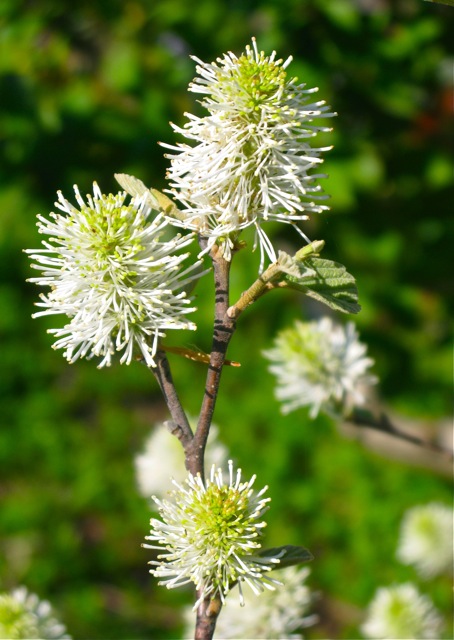 Fothergilla major ‘Mt Airy’ in May – Native American Witch Alder
Fothergilla major ‘Mt Airy’ in May – Native American Witch Alder
Is there anything more delightful than the sweet scent of blossoms on a sparkling spring morning? Nature never ceases to amaze me. I often marvel at the seasonal cycle here in my cold climate. In spite of my garden’s success, I still find it hard to believe that some of the more delicate-looking plants can survive winter’s wrath on this exposed hilltop. And yet every year, after months of frigid temperatures, brutal, blasting winds, and crushing snow topped with cracking ice, winter recedes and the blossoms return again. To me this is nothing short of a miracle.
The growing season in the Northeast is quite short. And the familiar, tongue-in-cheek saying, “New England has nine months of winter and three months of darn poor sledding”, never fails to bring a short, nervous burst of laughter amongst the locals. The temperatures here in Vermont have changed dramatically over the past few days, and over the weekend, I awoke to find a dusting of snow on my hilltop. Late spring snow always seems to stand out more in my memory than tardy autumn frost. Needless to say, in my work as a garden designer, and here in my own garden, extending seasonal enjoyment of the landscape is a big priority. And there are benefits to this multi-season approach no matter where you live…
One of my favorite early-spring blooming shrubs is very high on my list of ‘bests’ for autumn foliage. The native witch alder in my garden, (Fothergilla major and the compact Fothergilla gardenii), is currently smothered in beautiful white flowers and buzzing with honey bees. My tiny, winged garden guests are attracted to Fothergilla’s sweetly scented bottle brush blossoms and the ample pollen they provide in the early season. I absolutely adore this good garden ‘witch’, and long-time readers may recall my obsession with her late season color from my post on the subject last fall. If not, travel back and read more about this wonderful, woody plant by clicking here…
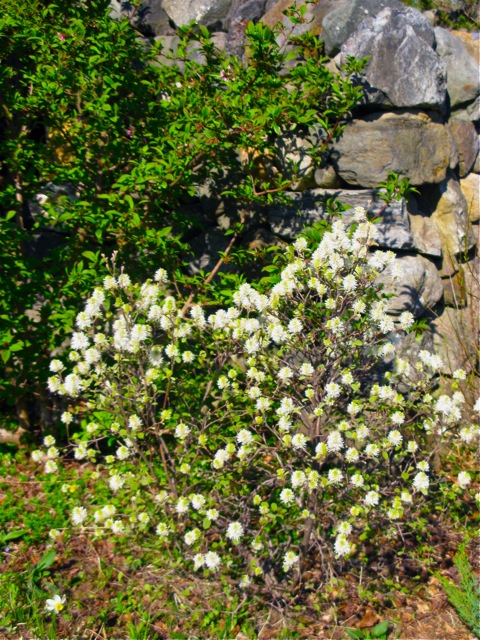 Fothergilla major ‘Mt Airy’ , (in closeup at top of post), is a lovely treat for bees in May…
Fothergilla major ‘Mt Airy’ , (in closeup at top of post), is a lovely treat for bees in May…
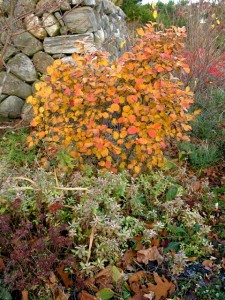 And she also glows again with various perennials in early November, luminous in the grey light…
And she also glows again with various perennials in early November, luminous in the grey light…
When it comes to my love-affair with the next shrub on my list, Viburnum carlesii, I am almost at a loss for words. As I pause to think back on our romantic history, I believe that my passion for the genus can be traced back to a Korean spice shrub planted beside the farmhouse next door to my childhood home. The slightly spicy, delicately sweet flowers of this lovely shrub were both familiar and exotic to my curious little nose. Every spring, I would invent excuses to ride my wobbly bike down the road, just to catch a whiff of those delightful blossoms on the breeze. Over time, I became acquainted with other members of this large and varied genus, and I have to admit that even now, no other woody plant -even the beloved Acer palmatum– can compete with my affection for viburnum.
Why such devotion? Well to begin with, although these shrubs aren’t always fragrant, some of the earliest blooming, and most beautifully scented flowers are produced by species of viburnum. The intensely fragrant Viburnum bodnantese ‘Dawn’ blooms at roughly the same time as the witch hazel in my zone 4/5 garden, filling the air with the most wonderful, almost edible, scent. Closely following V. bodnantense in flower is V. carlesii, (hardy in zone 4-8), better known as Korean spice shrub or Mayflower viburnum. This intoxicatingly fragrant shrub is the coveted Viburnum of my childhood memory, and her gorgeous great-grand daughter now occupies a prominent spot near my front door. Come autumn, her leaves will turn brilliant orange-red, (see photo below), and her shiny black fruits gleam amongst the glowing foliage like polished obsidian jewels….
 Viburnum carlesii – Beautifully fragrant pink blossoms delight in the spring garden…
Viburnum carlesii – Beautifully fragrant pink blossoms delight in the spring garden…
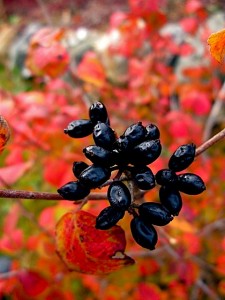 While ebony fruits and bright color make Korean spice a favorite come fall…
While ebony fruits and bright color make Korean spice a favorite come fall…
And the last spring-bloomer on today’s season-spanning shrub list -oh yes, you know there will be more coming- has to be Daphne x burkwoodii ‘Carol Mackie’. As a whole, Daphnes have a well-earned reputation for being somewhat temperamental garden plants. However, given the right siting -excellent drainage and protection from crushing snow and burning winter wind, is key- this season-spanning beauty will perform well in zones 4-7. There are other, equally lovely Daphne species and cultivars, however ‘Carol Mackie’ remains at the top of my list of favorites due to her glorious variegated foliage, which turns a honey-gold color in autumn; beautiful against the cool, dark stone landing at the entry to my Secret Garden. And the fragrant flowers in spring? Well, that is really the hook. I have a botanically-obsessed friend who cradles the blossoms in her hands every May, as if they were the rarest commodity on earth – and with good reason! The perfume is sensational; slightly musky with hints of clove and subtly sweet fruit. If only it could be bottled…
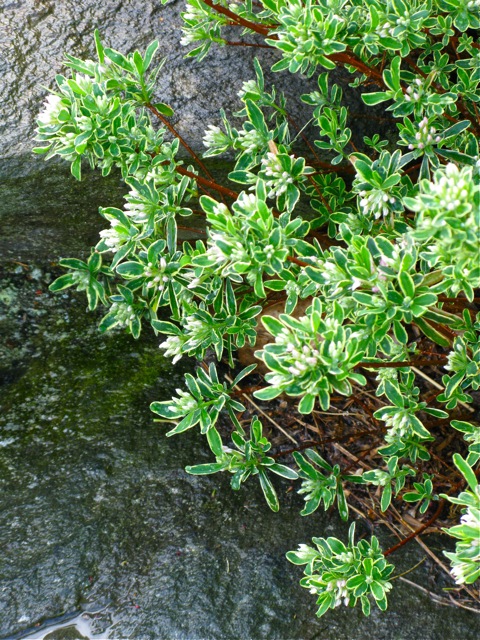 Daphne x burkwoodii ‘Carol Mackie’ – Lovely, fragrant pink blossoms and golden edged green leaves, this shrub turns a lovely golden hue in autumn..
Daphne x burkwoodii ‘Carol Mackie’ – Lovely, fragrant pink blossoms and golden edged green leaves, this shrub turns a lovely golden hue in autumn..
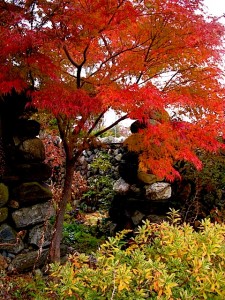 As shown here, (with Acer palmatum), in autumn
As shown here, (with Acer palmatum), in autumn
***
Article and photographs copyright, Michaela at TGE. All rights reserved.
All content on this site, (with noted exceptions), is the property of The Gardener’s Eden and may not be used or reproduced without prior written consent. Inspired by something you see here? Great! Please give credit where credit is due. It’s a small world and link-love makes for fond friendships. Stealing makes for bad dreams…
Do you enjoy visiting The Gardener’s Eden? You can help support this site by shopping through our affiliate links. A small percentage of any sale originating from The Gardener’s Eden site will go toward web hosting and maintenance costs. Thank you for your support!
***
5 Replies to “Season-Spanning Garden Design: Springtime Shrubs to Enjoy Now and Love Again Later – Three Favorites…”
Comments are closed.


These all sound wonderful. I have a bee hive and want to put in as many shrubs as I can to help them out! However, I seem to be short of cash and long on need at the moment. Will they grow from cuttings? I love propagating my own plants when I can. My most recent specimen is a native hydrangea which is now ready to go in the ground!
Thanks for all your lovely postings! ~ L
Hi Lynda, thanks for the great question. Viburnum carlesii is relatively easy to root from young wood cuttings taken in June or early July. Use rooting solution for best results. Fothergilla is also very easy to propagate, however best results from this one come from root cuttings taken from a well-established, suckering specimen. Daphne is a tough plant to propagate, even for experienced horticulturalists. I don’t discourage you from trying with cuttings, but know that this one may be difficult, and perhaps you will have better luck with the other two. For late season bee-friendly flowers, try rooting Clethra alnifolia. I will be writing about more flowering shrubs for pollinators soon! xo Michaela
good morning michaela,i have a viburnun carlesii just outside my front door and a dark pink crab apple canopys over it all with steps near by to sit with tea and get drunk from the scent of both. my bees love both. we are expecting 3 inches of wet snow today! this weekend it is supposed to warm up-hopefully for good!
Fothergilla in my garden is a star, for all the reasons you give here. I love the bottlebrushes. The scent is faint, but there is a whiff of honey if I get close. I’d love to try a Koreanspice viburnum, but I fear it might get too big for where I want to put it. Hmmm, maybe if I move some things…..
I also love the Korean spice viburnum. Doing my spring chores anywhere in a fifty-food radius of it is a pleasure for the week or two it’s in bloom. Thanks for reminding me about Carol Mackey — I lost mine a couple of winters ago when it split from heavy snow. Maybe it’s time to try again!